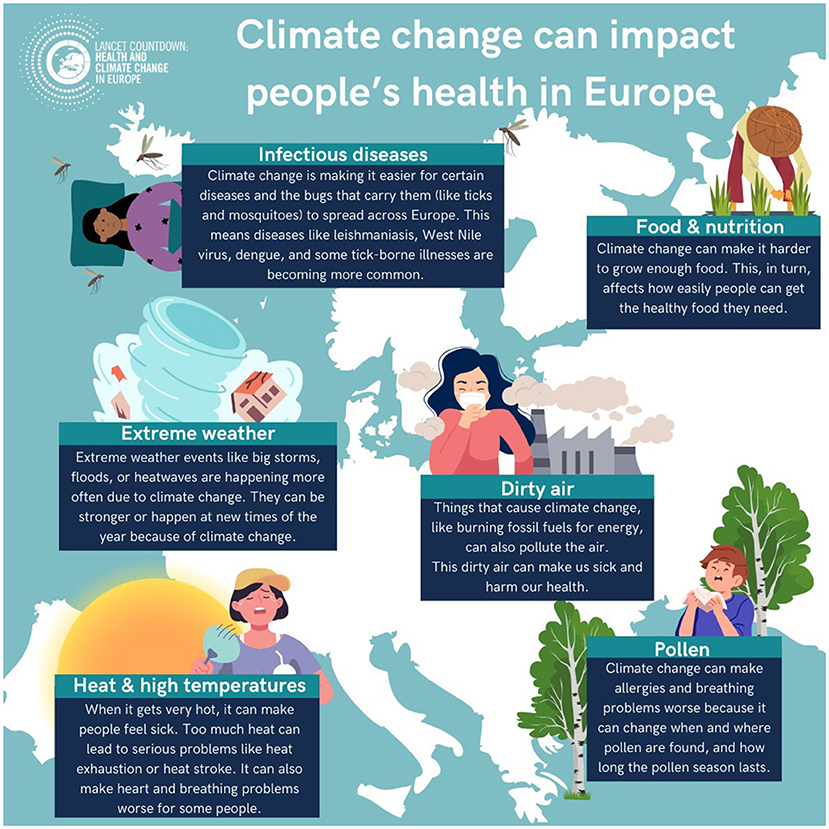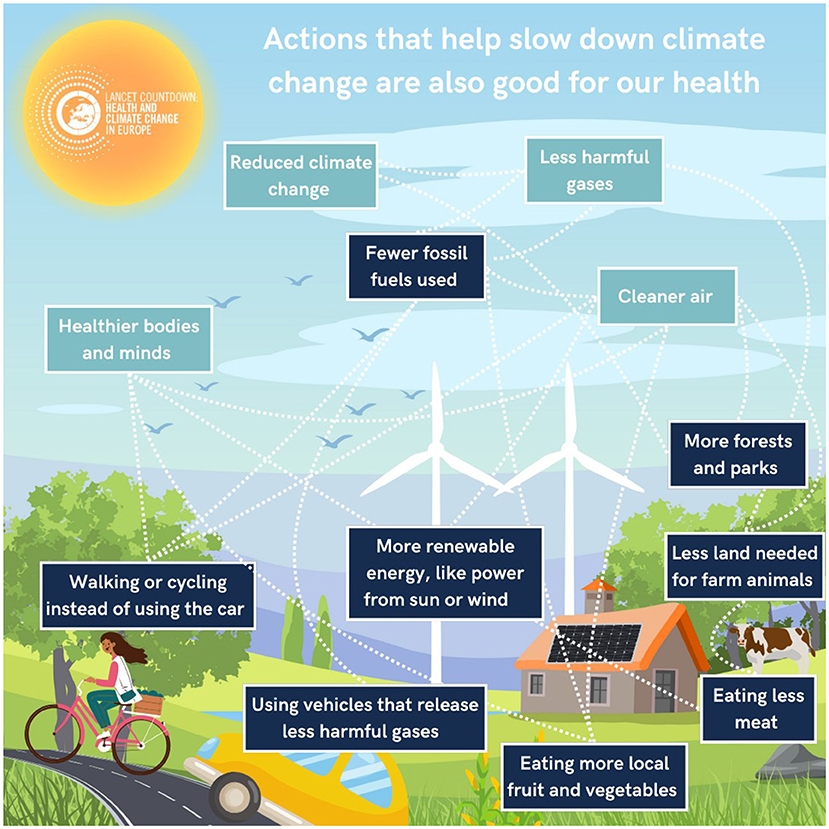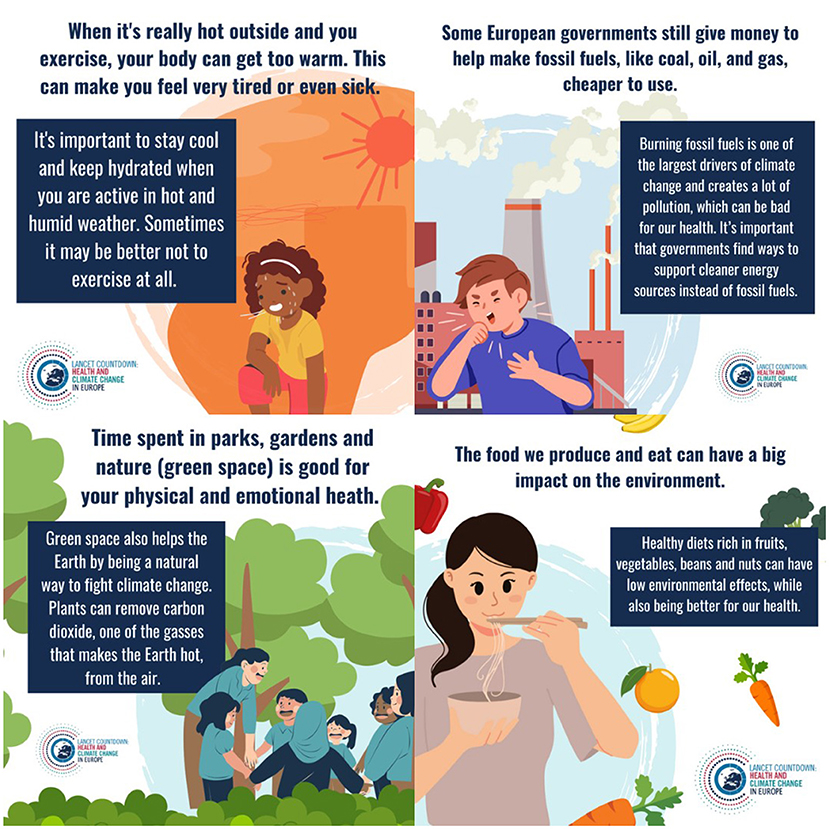Abstract
Climate change is rapidly warming our planet, and Europe is heating up twice as fast as the rest of the world. You may have heard about polar bears being affected by melting ice caps, but did you know climate change affects humans too? Extreme weather events, like storms, droughts, floods, heatwaves, and wildfires, are becoming more common — leading to a rise in health issues including injuries, heart and lung disease, depression, diseases spread by mosquitoes, and food and water shortages. To protect people’s health from climate change, we need to develop solutions to protect those who are most affected, like older people, children, people with disabilities, and people who have fewer opportunities and less support than others. Climate change may seem like a problem too big to fix, but together we can protect ourselves and each other and provide a lot of health benefits. Climate action is a win-win for people and the planet!
What is Climate Change?
Think about the Earth’s atmosphere as a big, cozy blanket. This blanket, made up of gases like carbon dioxide and methane, keeps us warm. The gases trap the sun’s heat, so our planet does not get too cold. When humans burn coal, oil, and gas for energy, we add more gases to the air than should be there. It is like adding more and more layers to the blanket. A thicker blanket is nice if we are cold, but if we are already warm it can make us too hot. These extra gases are making Earth too hot. This is called the greenhouse effect. A greenhouse is a building made from glass, used to grow plants. Sunlight shines through the glass and warms the air inside. The glass traps the heat, making the air inside the greenhouse warm, even at night and during winter. Therefore, the gases that warm the Earth are called greenhouse gases. The Earth’s extra warmth is called global warming, and it is changing weather patterns and making temperatures hotter, with more storms, floods, droughts, and wildfires. These changes are harmful for people, animals, and plants that are used to the weather patterns we had before humans released so many greenhouse gases into the air.
Unequal Responsibility for Climate Change
Rich countries and big companies have caused a lot of the climate problem by burning too much coal, oil and gas for energy, which are called. But rich countries and most companies are not doing enough to fix it [1]. For example, some European countries have produced a lot of greenhouse gases compared to many other countries. In 2021, the greenhouse gases emitted by each person in Europe from burning fossil fuels were six times higher than in Africa, and almost three times higher than in Central and South America [2]. Even within wealthy countries, there are big differences in how much pollution people create. Richer people and businesses often burn more fossil fuels compared to others. This is very unfair, as the people and places that have not used as much fossil fuels are often the hardest hit by climate change. Europe and other rich regions and industries must do their part and burn less fossil fuels to protect the health of people, animals, and plants all over the world.
How Does Climate Change Affect Human Health?
Over the last 50 years, scientists have discovered many ways that climate change affects our health (Figure 1). For example, heatwaves are happening more often, making it hard to keep our bodies cool. Extreme heat can be dangerous, especially for older people, those who already suffer from diseases, and people who work outdoors, such as builders and farmers. In Europe, temperatures are becoming so hot that it can be dangerous to exercise or play outdoors in the middle of the day without proper shade [3, 4]. Combined with extreme heat, air polluted with greenhouse gases and particles can lead to heart and lung diseases. Droughts can lead to plants not getting enough water to produce food, making it harder for people to eat and stay healthy. At the same time, there may not be enough water for humans and animals to drink or clean themselves. Droughts can also contribute to wildfires that burn large areas of forests and create a lot of smoke. Smoke contains tiny particles that can make it hard to breathe, cause coughing, and irritate our eyes. Climate change can also shift and lengthen the flowering season for trees, making pollen allergies and asthma worse for longer periods of the year [3].

- Figure 1 - How climate change affects human health (Figure credit: Lancet Countdown in Europe).
As if this is not enough, climate change can also make it easier for infectious diseases to spread. Infectious diseases are illnesses caused by tiny germs (e.g., viruses, bacteria, parasites) that can move from person to person, or from an animal or insect to a person. As the weather gets warmer, these diseases can spread to new places that used to be too cold for them. Warmer weather creates better conditions for ticks and many insects, like mosquitoes and sandflies, which feed on the blood of both animals and humans. Bites from these insects can transmit infectious diseases such as dengue, malaria, West Nile virus, Lyme disease, and leishmaniasis, which can make people very sick. As more people travel around the world in airplanes, infectious diseases spread to new regions. Doctors, veterinarians, and pest-control teams must be on the lookout for infectious diseases they have not had to deal with in the past.
Adapting to a Changing Climate
In addition to reducing greenhouse gases, Europe needs to stop the harmful health impacts of climate change from getting worse. This is called climate change adaptation, and it includes creating early warning systems that can warn people about things like heatwaves, floods, or disease outbreaks. An early warning system, just like the weather forecasts you see on the news, can help keep us safe by letting us know about dangerous events before they happen. If alerts are shared early, governments and individuals can prepare in advance and try to minimize potential disruption, damage, and bad health outcomes.
As more people move to cities, urban areas must be designed to deal with higher temperatures and extreme weather. This could include planting more trees to provide shade and creating green spaces, like parks, gardens, or urban forests. Plants help the Earth to fight climate change naturally by removing carbon dioxide from the atmosphere. Cities can also reduce the amount of heat-trapping pavement and improve buildings to make them stronger and cooler. Strong health systems are also important to adapt to climate change. Doctors, nurses, hospitals, and healthcare centers need to be ready to handle the new health challenges from climate change, including heat-related illnesses and new infectious diseases.
Health Benefits of Climate Action
Although the health harms from climate change may sound scary, there is good news! Doing things to reduce greenhouse gas emissions can have many positive effects, such as cleaner air, cleaner water, more healthy food, stronger health systems, better public health, and more environmentally friendly technologies (Figure 2). These changes will also improve people’s health. Reducing greenhouse gas emissions is a win–win situation for both people and the planet. This action slows down climate change and its harmful impact on health, but it also makes people healthier in other ways. For example, when we burn fewer fossil fuels, the air becomes cleaner and fewer people get sick from breathing polluted air. Walking or riding a bike instead of driving a car helps keep the air clean and helps people keep fit and healthy. Producing meat from cows and sheep (also called red meat) releases large amounts of greenhouse gases. Eating less red meat and more beans, whole grains, fruits, and vegetables reduces emissions and improves our health at the same time. Healthy diets based mainly on plants reduce the risk of heart disease and other health problems.

- Figure 2 - Actions that help slow down climate change and are also good for human health.
- Dark blue boxes represent actions that individuals, communities and governments can take. Light blue boxes indicate positive outcomes of these actions to slow down climate change and improve human health. Each action is connected with the corresponding benefit using dotted lines (Figure credit: Lancet Countdown in Europe).
Ignoring climate change can be very expensive now and in years to come. Extreme weather, such as storms and floods, can damage buildings, roads, bridges, and homes. Health problems caused by climate change can also be expensive for doctors and nurses to treat. At the same time, investing in renewable energy, which is energy generated by nature, like wind, water, and sunshine, can save money in the long run. For example, switching to renewable energy could create new jobs and opportunities. By preventing damage and health problems caused by extreme weather, countries can save a lot of money. This money can be used for other important things, like better schools and hospitals.
Several infographics illustrating the various impacts of climate change on human health, as well as the health co-benefits of climate action, are available online; examples are shown in Figure 3.

- Figure 3 - Four example infographics on climate and health.
- This figure showcases four sample infographics illustrating how climate change and health are connected. Each highlights a different theme: heat, fossil fuels, green spaces and food. All individual infographics are available at: https://idalertproject.eu/lancet-countdown-indicators-young-minds (Figure credit: Lancet Countdown in Europe).
Taking Action Together
People are becoming more aware of the health harms of climate change. However, individuals, businesses, and the news are not talking enough about this important issue. In the European Parliament, where politicians from multiple European countries make important decisions, there is growing talk about climate change. However, more attention is needed on how climate change affects people’s health. When leaders understand this connection, they can make better choices to protect both the environment and public health [3, 4].
Governments, businesses, and communities need to work together to fight climate change. Governments can create laws that reduce greenhouse gas emissions and help those whose jobs are affected by less use of fossil fuels. Laws and other government actions could include setting limits on how much greenhouse gases each country can release, investing in renewable energy, supporting public transportation, and building more bike lanes and green spaces. The early cost of fixing climate change is worthwhile because it helps us avoid larger expenses and damage in the long run.
Businesses can help by polluting less, by using more renewable energy, and by creating products that are more environmentally friendly. Scientists can help by communicating their findings on climate and health in a clear, easy-to-understand way. People who share news, like journalists and social media users, can share more about how climate change affects our health, to help everyone understand why taking care of our planet is so important for keeping people healthy. The public can help by making small changes in their daily lives, such as eating less red meat and more fruit and vegetables, or by walking or biking instead of traveling by car. You can also talk to your friends and family about how climate change affects health and how taking climate action can benefit health. The more people understand this connection, the more they might want to help. By taking action against climate change, we not only protect the planet but also make our lives healthier and safer. Every action, both big and small, helps fight climate change and protects our health. Together, we can and will make a big impact!
Glossary
Greenhouse Gases: ↑ Gases that act like a blanket around Earth, including carbon dioxide, methane, and nitrous oxide. In normal amounts, they help keep our planet warm enough to live on.
Floods: ↑ When water overflows from rivers, lakes, or the sea onto the land that is normally dry, like roads or fields. This usually results from a lot of rain or melting snow.
Droughts: ↑ Periods when everything gets really dry, usually due to long periods without much rain. Water sources can dry up, making it hard for plants, animals, and crops to survive.
Wildfires: ↑ Big fires that spread quickly over vegetated areas like forests or grasslands.
Fossil Fuels: ↑ Energy sources like coal, oil, and natural gas that formed millions of years ago from dead plants and animals buried underground.
Infectious Diseases: ↑ Illnesses caused by tiny germs like bacteria, viruses, parasites, or fungi that can spread from one person to another or from an insect or tick to another person.
Emissions: ↑ Release of gases into the air, through burning fuel to power cars and make electricity, or when cows digest their food.
Renewable Energy: ↑ Energy that comes from natural sources like the sun, wind, or water. Renewable energy does not cause pollution or greenhouse gas emissions like burning fossil fuels does.
Conflict of Interest
The authors declare that the research was conducted in the absence of any commercial or financial relationships that could be construed as a potential conflict of interest.
Acknowledgments
The Lancet Countdown is supported by the Wellcome Trust (grant number 304972/Z/23/Z). The Lancet Countdown in Europe acknowledges funding from the European Union’s Horizon Europe research and innovation programme under grant agreement No. 101057131 (Horizon Europe project CATALYSE, https://catalysehorizon.eu/) and grant agreement No. 101057554 (Horizon Europe project IDAlert, https://idalertproject.eu). CATALYSE and IDAlert are part of the EU climate change and health cluster (https://climate-health.eu). R.L. acknowledges a Royal Society Dorothy Hodgkin Fellowship. KRvD was funded by the BHF Cambridge Centre for Research Excellence RE/24/130011. We are grateful to the young minds who provided feedback on the article before submission to make it more appealing to a young audience including Mateo, Dylan, Wilhelmina, Gustav, Pelle, Nina, and Elizabeth. The authors used AI tools to check technical terms and definitions for the target audience. It was not used to shape the final narrative or to create the figures.
Original Source Article
↑Romanello, M., van Daalen, K., Anto, J. M., Dasandi, N., Drummond, P., Hamilton, I. G., et al. 2021. Tracking progress on health and climate change in Europe. Lancet Public Health 6:e858–865. doi: 10.1016/S2468-2667(21)00207-3
References
[1] ↑ van Daalen, K. R., Tonne, C., Borrell, C., Nilsson, M., and Lowe, R. 2023. Approaching unsafe limits: climate-related health inequities within and beyond Europe. Lancet Reg. Health Eur. 31:100683. doi: 10.1016/j.lanepe.2023.100683
[2] ↑ Romanello, M., Di Napoli, C., Green, C., Kennard, H., Lampard, P., Scamman, D., et al. 2023. The 2023 report of the Lancet Countdown on health and climate change: the imperative for a health-centred response in a world facing irreversible harms. Lancet 402:2346–94. doi: 10.1016/S0140-6736(23)01859-7
[3] ↑ Van Daalen, K. R., Tonne, C., Semenza, J. C., Rocklöv, J., Markandya, A., Dasandi, N., et al., 2024. The 2024 Europe report of the Lancet Countdown on health and climate change: unprecedented warming demands unprecedented action. Lancet Public Health 9:e495–522. doi: 10.1016/S2468-2667(24)00055-0
[4] ↑ van Daalen, K. R., Romanello, M., Rocklöv, J., Semenza, J. C., Tonne, C., Markandya, A., et al. 2022. The 2022 Europe report of the Lancet Countdown on health and climate change: towards a climate resilient future. Lancet Public Health 7:e942–65. doi: 10.1016/S2468-2667(22)00197-9
